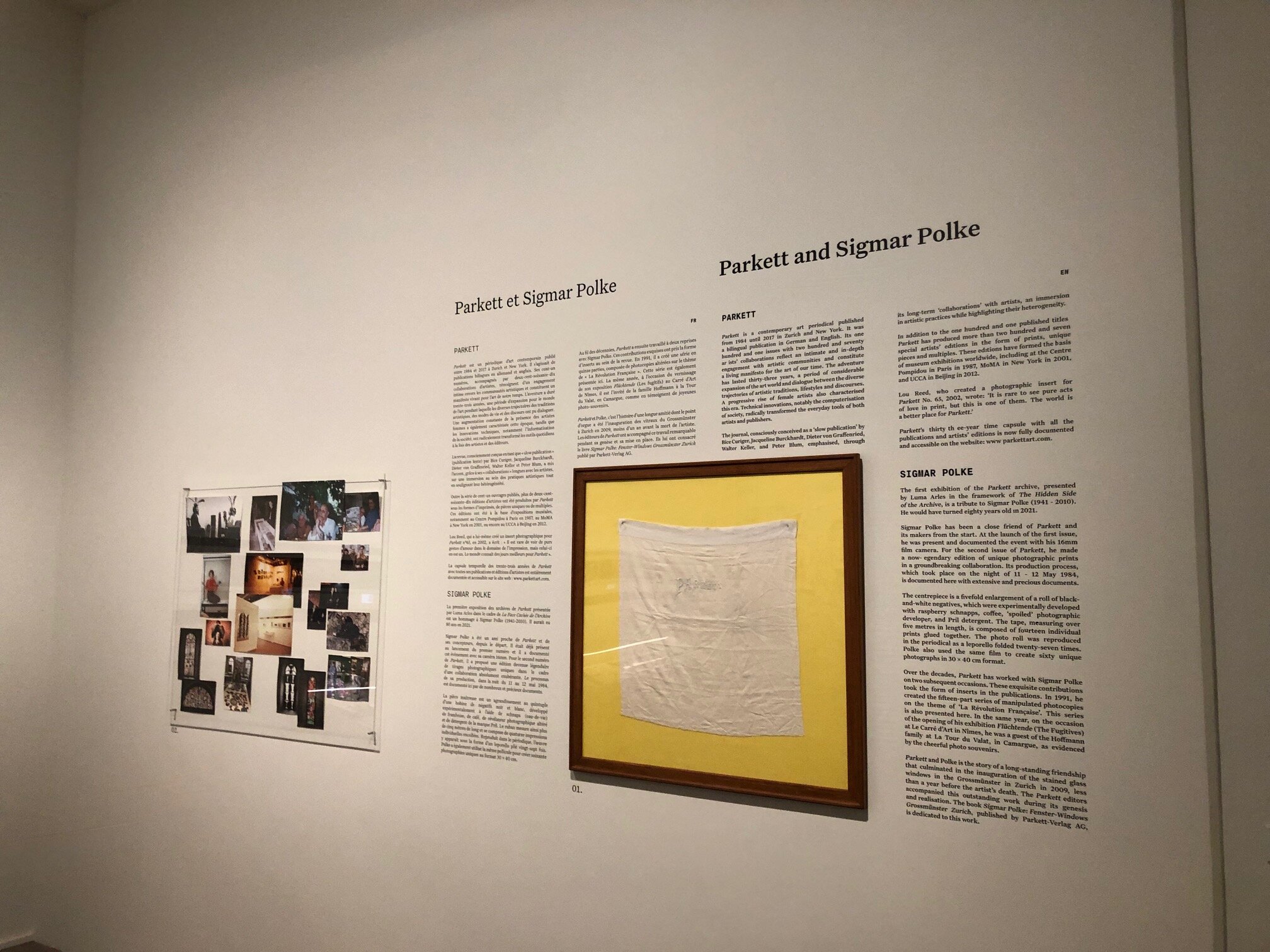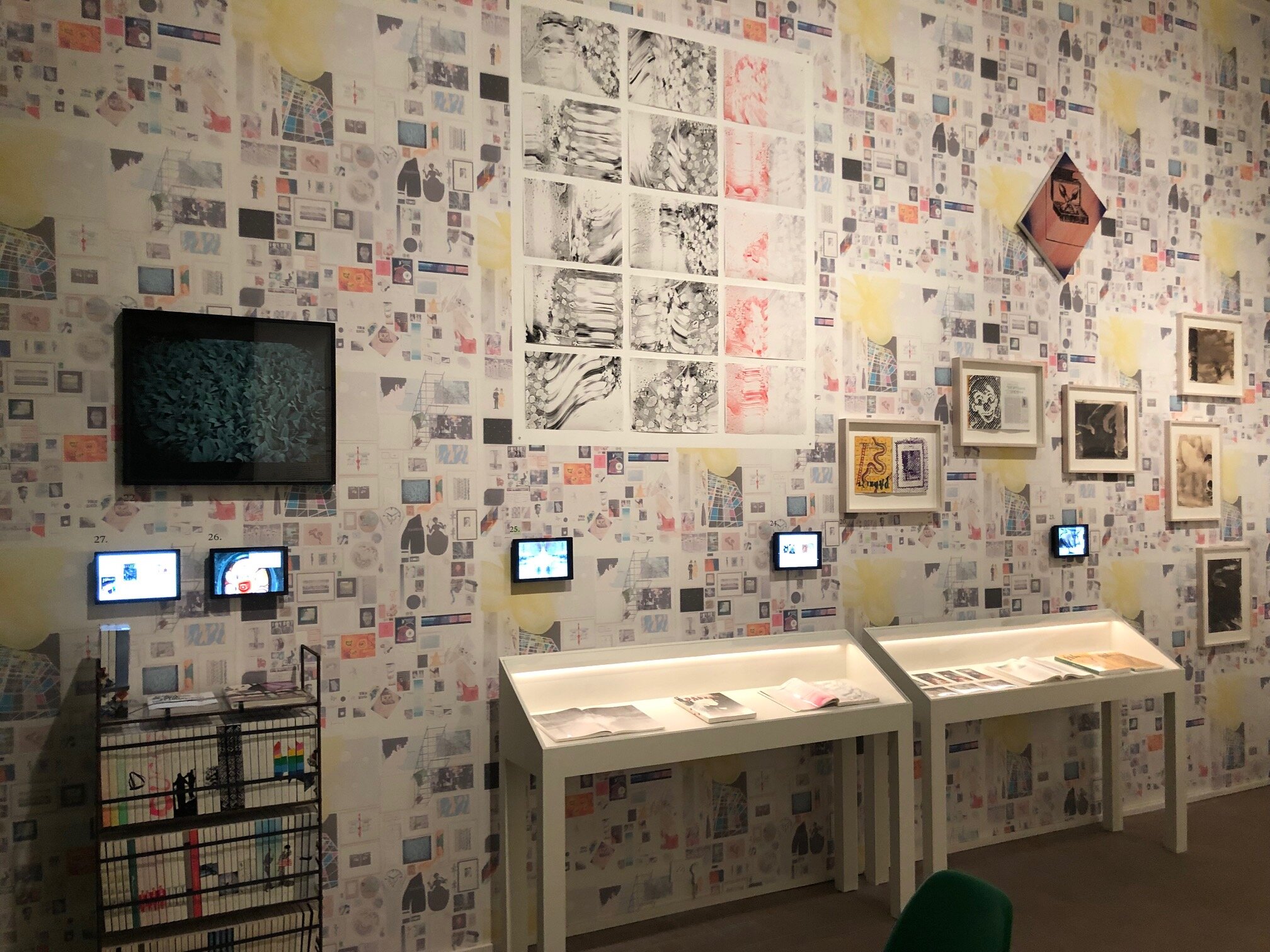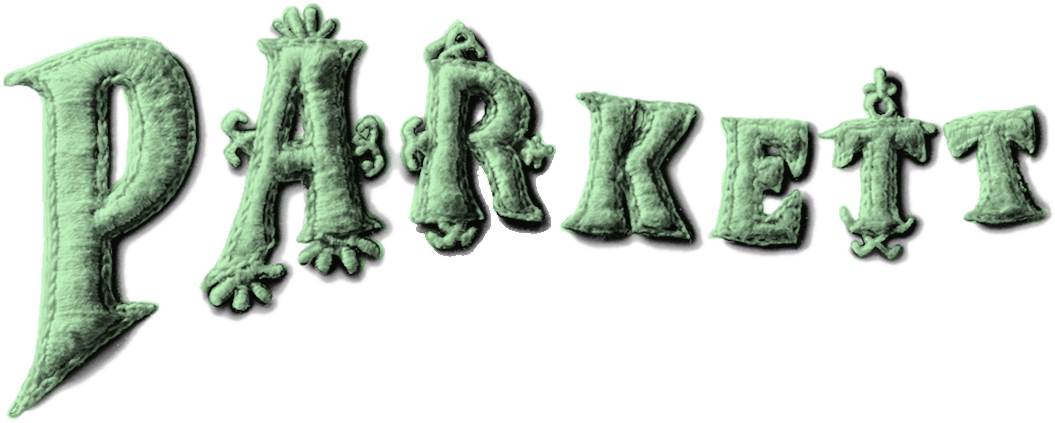 Image 1 of 5
Image 1 of 5

 Image 2 of 5
Image 2 of 5

 Image 3 of 5
Image 3 of 5

 Image 4 of 5
Image 4 of 5

 Image 5 of 5
Image 5 of 5






LUMA Arles, 2021, Opening Exhibitions, with the Parkett Archive
LUMA Arles, founded by Maja Hoffman, opened it’s one-of-a-kind cultural center in Arles, France on June 25, 2021. Around twenty exhibitions and artists’ projects explore multiple aspects of art, culture, environment, education and research on the twelve hectares “Parc des Ateliers” with ten buildings including the stunning twisted tower by Frank Gehry.
On view in Luma’s Living Archives section is Parkett with a special first focus on its three collaborations with Sigmar Polke spanning ten years. The archive section includes further presentations on Annie Leibovitz, Derek Jarman, Diane Arbus, and Nan Goldin.
Other Luma exhibitions on view feature artists including Philippe Parreno, Christian Marclay, Dominique Gonzalez-Foerster, Isa Genzken, Fischli/Weiss, Mike Kelley, Anri Sala, Pierre Huyghe, Franz West, Kerstin Brätsch, Liam Gillick, Rirkrit Tiravanija, and others, who have also collaborated over time with Parkett.
Parkett and Sigmar Polke
The first exhibition of the Parkett archive, presented by Luma Arles in the framework of “The Hidden Side of the Archive”, is a tribute to Sigmar Polke (1941-2010). He would have turned eighty years old in 2021.
Sigmar Polke has been a close friend of Parkett and its makers from the start. At the launch of the first issue, he was present and documented the event with his 16mm film camera. For the second issue of Parkett, he made the now legendary “Desastres” edition of unique photographic prints in a groundbreaking collaboration. Its production process, which took place on one night in 1984, is documented here with extensive and precious photos, sketches, the original prototype, and more.
The centerpiece is the five-fold enlargement of a roll of black-and-white negatives, which were experimentally developed with raspberry schnapps, coffee, ‘spoiled’ photographic developer, ad Pril detergent. The tape, measuring over five metres in length, is composed of fourteen individual prints glued together. The photo roll was reproduced in the entire print run of the periodical as a leporello folded twenty-seven times. Polke also used the same film to create sixty unique photographs in 30 x 40 cm format.
Over time, Parkett has worked with Sigmar Polke on subsequent occasions. These exquisite contributions also took the form of inserts in the publications. In 1981, he created the fifteen-part series of manipulated photocopies on the theme of ‘La Révolution française’, which is on view as well.
Parkett and Polke is the story of a long-standing friendship that culminated in the inauguration of the stained glass windows in the Grossmünster in Zurich in 2009, shortly before the artists’ death. The Parkett editors accompanied this outstanding work during its genesis and realization. The book “Sigmar Polke: Fenster-Windows Grossmünster Zurich”, published by Parkett, fully illustrates and documents this work.
The Hidden Side of the Archive
Often compared to sanctuaries, to those places that are protected and that protect the events of time, archives bring an undeniable comfort of mind with their rational classifications and rigorous arrangements. The restitution of the past requires the greatest acuity in order to consolidate this edifice that we call History. However, it is often necessary to belong to the restricted circles of historians, specialists, or researchers to access these hidden treasures.
The Living Archives of Luma Arles have been designed around a central block around which units are dedicated to a varied and open panel of artistic actors. Flexible and mobile, they give rise to temporary exhibitions in which the archives are thought out, gathered, and staged by their depositors or in a manner that is as close as possible to theirs.
At times, an archive that permanently enters into a repository perennially captures this reverse shot that is the life itself. It can preserve, beyond its historical character, a trace that is still alive, like a radioactive particle travelling across time. It is thus possible for it to carry within itself the key to a well-kept mystery and to illuminate events with a new and definitive meaning. In other cases, the archive can be though and staged by the artists themselves, in a manner that praises the art of revelation as much as it praises poetry.
Thus, the process of archiving deserves special attention when the artists, conscious of the persistence of their messages, add to their gesture an aspect that is both powerful and ghostly.
Testamentary wager, battle against finitude, testimony in extremis, rearrangement of time and other time-related equations are all at the heart of the The Hidden Side of the Archive., which invites us to put aside our habits of analytical reflection and instead embrace a perception that is both emotional and empathetic. The challenge here is no longer to define or to demonstrate, but to feel. The archive is then, beyond a memory, a mirror that is held up towards us….”
- Matthieu Humery, curator, Luma Arles
Living Archives
”The concept of Living Archives embodies, in my eyes, the desire to open up a space that would be accessible to all, modular, and experimental, by emphasizing, beyond the traditional forms of knowledge, the current notions of feeling and experience.
With the Living Archives, we aspire to make a contribution to the tradition of archives by incorporating in a more organic and open dimension, in close collaboration with artists, thinkers, and actors of these collaborations.
In an age where everything is accelerating, our ambition to slow down the process of historicisation, to make the transition from one era to another more intelligible, and to offer a dynamic reflection in relation to the recent past. With this approach, which transforms History into an organic material in constant search of interpretation, we hope to facilitate a better understanding of the world in which we live.
In line with this perspective our first exhibition “The Hidden Side of the Archive,” explores the intimate side of the archive where biography, marked by the intensity of events, activates and triggers the process of memory.
…
My unshakable friendship with two of the founders of Parkett magazine goes back to the very beginning of the publication, whose issues I have collected in their entirety ever since. Bice Curier introduced me to Sigmar Polke, an artist whose collaborations with the magazine have remained a legend, during his 1991 retrospective at the Hirshhorn Museum in Washington, D.C.. We decided together to highlight in this presentation, their successive artistic and intellectual collaborations. The documents related to the preparation of these editions, as well as the personal archives of the editors, are now an integral part of Luma’s living archives.
…
The Hidden Side of the Archive is ultimately mine, in many respects.”
- Maja Hoffman, founder, Luma Arles
LUMA Arles, founded by Maja Hoffman, opened it’s one-of-a-kind cultural center in Arles, France on June 25, 2021. Around twenty exhibitions and artists’ projects explore multiple aspects of art, culture, environment, education and research on the twelve hectares “Parc des Ateliers” with ten buildings including the stunning twisted tower by Frank Gehry.
On view in Luma’s Living Archives section is Parkett with a special first focus on its three collaborations with Sigmar Polke spanning ten years. The archive section includes further presentations on Annie Leibovitz, Derek Jarman, Diane Arbus, and Nan Goldin.
Other Luma exhibitions on view feature artists including Philippe Parreno, Christian Marclay, Dominique Gonzalez-Foerster, Isa Genzken, Fischli/Weiss, Mike Kelley, Anri Sala, Pierre Huyghe, Franz West, Kerstin Brätsch, Liam Gillick, Rirkrit Tiravanija, and others, who have also collaborated over time with Parkett.
Parkett and Sigmar Polke
The first exhibition of the Parkett archive, presented by Luma Arles in the framework of “The Hidden Side of the Archive”, is a tribute to Sigmar Polke (1941-2010). He would have turned eighty years old in 2021.
Sigmar Polke has been a close friend of Parkett and its makers from the start. At the launch of the first issue, he was present and documented the event with his 16mm film camera. For the second issue of Parkett, he made the now legendary “Desastres” edition of unique photographic prints in a groundbreaking collaboration. Its production process, which took place on one night in 1984, is documented here with extensive and precious photos, sketches, the original prototype, and more.
The centerpiece is the five-fold enlargement of a roll of black-and-white negatives, which were experimentally developed with raspberry schnapps, coffee, ‘spoiled’ photographic developer, ad Pril detergent. The tape, measuring over five metres in length, is composed of fourteen individual prints glued together. The photo roll was reproduced in the entire print run of the periodical as a leporello folded twenty-seven times. Polke also used the same film to create sixty unique photographs in 30 x 40 cm format.
Over time, Parkett has worked with Sigmar Polke on subsequent occasions. These exquisite contributions also took the form of inserts in the publications. In 1981, he created the fifteen-part series of manipulated photocopies on the theme of ‘La Révolution française’, which is on view as well.
Parkett and Polke is the story of a long-standing friendship that culminated in the inauguration of the stained glass windows in the Grossmünster in Zurich in 2009, shortly before the artists’ death. The Parkett editors accompanied this outstanding work during its genesis and realization. The book “Sigmar Polke: Fenster-Windows Grossmünster Zurich”, published by Parkett, fully illustrates and documents this work.
The Hidden Side of the Archive
Often compared to sanctuaries, to those places that are protected and that protect the events of time, archives bring an undeniable comfort of mind with their rational classifications and rigorous arrangements. The restitution of the past requires the greatest acuity in order to consolidate this edifice that we call History. However, it is often necessary to belong to the restricted circles of historians, specialists, or researchers to access these hidden treasures.
The Living Archives of Luma Arles have been designed around a central block around which units are dedicated to a varied and open panel of artistic actors. Flexible and mobile, they give rise to temporary exhibitions in which the archives are thought out, gathered, and staged by their depositors or in a manner that is as close as possible to theirs.
At times, an archive that permanently enters into a repository perennially captures this reverse shot that is the life itself. It can preserve, beyond its historical character, a trace that is still alive, like a radioactive particle travelling across time. It is thus possible for it to carry within itself the key to a well-kept mystery and to illuminate events with a new and definitive meaning. In other cases, the archive can be though and staged by the artists themselves, in a manner that praises the art of revelation as much as it praises poetry.
Thus, the process of archiving deserves special attention when the artists, conscious of the persistence of their messages, add to their gesture an aspect that is both powerful and ghostly.
Testamentary wager, battle against finitude, testimony in extremis, rearrangement of time and other time-related equations are all at the heart of the The Hidden Side of the Archive., which invites us to put aside our habits of analytical reflection and instead embrace a perception that is both emotional and empathetic. The challenge here is no longer to define or to demonstrate, but to feel. The archive is then, beyond a memory, a mirror that is held up towards us….”
- Matthieu Humery, curator, Luma Arles
Living Archives
”The concept of Living Archives embodies, in my eyes, the desire to open up a space that would be accessible to all, modular, and experimental, by emphasizing, beyond the traditional forms of knowledge, the current notions of feeling and experience.
With the Living Archives, we aspire to make a contribution to the tradition of archives by incorporating in a more organic and open dimension, in close collaboration with artists, thinkers, and actors of these collaborations.
In an age where everything is accelerating, our ambition to slow down the process of historicisation, to make the transition from one era to another more intelligible, and to offer a dynamic reflection in relation to the recent past. With this approach, which transforms History into an organic material in constant search of interpretation, we hope to facilitate a better understanding of the world in which we live.
In line with this perspective our first exhibition “The Hidden Side of the Archive,” explores the intimate side of the archive where biography, marked by the intensity of events, activates and triggers the process of memory.
…
My unshakable friendship with two of the founders of Parkett magazine goes back to the very beginning of the publication, whose issues I have collected in their entirety ever since. Bice Curier introduced me to Sigmar Polke, an artist whose collaborations with the magazine have remained a legend, during his 1991 retrospective at the Hirshhorn Museum in Washington, D.C.. We decided together to highlight in this presentation, their successive artistic and intellectual collaborations. The documents related to the preparation of these editions, as well as the personal archives of the editors, are now an integral part of Luma’s living archives.
…
The Hidden Side of the Archive is ultimately mine, in many respects.”
- Maja Hoffman, founder, Luma Arles




